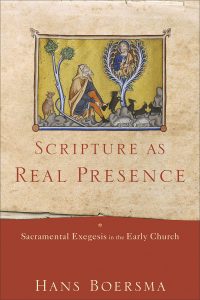
I just finished Hans Boersma’s Scripture as Real Presence: Sacramental Exegesis in the Early Church (Baker: 2017). A fascinating read. The title should be suggestive to us Calvinists: we believe in the real presence of Christ in the Supper, namely that the body and blood of Christ are “as really, but spiritually, present to the faith of believers in [the Supper], as the elements themselves are to their outward senses” (WCF 29.7).
Boersma is making a similar point about Scripture: the Old Testament is “a sacrament, in which the New Testament realities of Christ and the church are already present” (p. 103). The OT “already contains the New Testament reality (res) of Christ” (p. xv; emphasis his). Therefore, just as the point of the sacraments is union with Christ, so also the point of reading the Bible is union with the savior.
Boersma then mines his considerable expertise in the early church fathers to give examples of this approach to scripture:
- Origen discusses the rather obscure event of the transjordan tribes setting up an altar in Josh 22:10–20 and then asks, “But let us see what sacrament lies within this deed” (p. 122).
- For the Exodus, Theodoret equates the Red Sea with the baptismal font (cf. 1 Cor 10:2); the cloud with the Holy Spirit; Moses as a type of Christ; the staff as a type of the cross; Pharaoh as a type of the devil and the Egyptians of the fallen angels; manna is the divine food (i.e., the Eucharist), and the water from the rock is the Savior’s blood (p. 91). Almost all of these typological parallels find explicit support in the NT, and the others follow quite naturally.
- Ambrose read Prov 27:6 (“Faithful are the wounds of a friend; profuse are the kisses of an enemy.”) and saw Christ: the wound of Christ, our friend, benefits us (p. 246). (Which I guess you could understand as both his being wounded for us on the cross, and also how he wounds us with the convicting words of Scripture in order to bring us to himself).
- Origen read the erotic descriptions of the Song of Songs as fulfilling their proper created purpose when they lead the soul to union with Christ (p. 208).
In making these connections, Boersma supports Daniélou’s thesis that “we can properly understand the fathers only by regarding their interpretation as an extension of the typology that the Scriptures themselves employ” (p. 84). In other words, we learn how to read the scriptures by looking at how the scriptures interpret themselves.
I find all of this quite encouraging. Yes, we always have to be careful not to free-associate and leap on the first ad-hoc connections that spring to mind. We have to respect what the text is saying, and our connections to Jesus should emerge from the trajectories of the text. But the impulse of the fathers is right: the OT shows us the glory of Jesus. So we should always be looking for him there. It’s not that he is extrinsic to the OT and we’re “forcing him” on the text. He’s already there.
But I feel like Boersma’s book takes this truth to an even higher level. Reading the OT as a sacrament means we expect not only to learn of Christ, but to actually meet him there; to experience union with him; to experience, in short, his real presence.

Thank you Pastor, this was extremelyt helpful. It truly gives a greater expectancy in reading the OT if we are looking to experience Christ’s real presence in reading it.